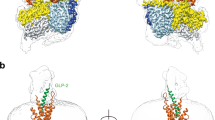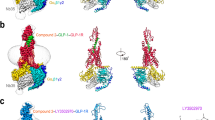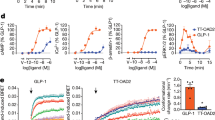Abstract
Glucagon specifically inhibits the Ca2+ pump in liver plasma membranes independently of adenylate cyclase activation1. However, this inhibition is only observed at high concentrations of glucagon (Ki = 0.7 µM). Moreover, in the presence of bacitracin, an inhibitor of glucagon degradation2, the Ca2+ pump is no longer sensitive to glucagon3. These findings suggest that a fragment of glucagon might be the true effector of the liver Ca2+ pump. Pairs of basic amino acids are recognized as potential cleavage sites in post-translational processing of peptide hormones4–6. The glucagon molecule includes a dibasic doublet (Arg 17–Arg 18). Therefore, we have examined the action of glucagon( 19–29) on the liver Ca2+ pump. This peptide was obtained from glucagon by tryptic cleavage and separated by reverse-phase high-performance liquid chromatography. We found that glucagon( 19–29), which is totally ineffective in activating adenylate cyclase, inhibited both the Ca2+-activated and Mg2+-dependent ATPase activity ((Ca2+-Mg2+) ATPase) and Ca2+ transport in liver plasma membranes with an efficiency 1,000-fold higher than that of glucagon. Glucagon(l–21) was completely inactive; glucagon( 18–29) and glucagon(22–29) acted only as partial agonists of glucagon( 19–29). These results indicate that glucagon( 19–29), obtained by proteolytic cleavage of glucagon, is likely to be the active peptide involved in the inhibition of the liver Ca2+ pump. We suggest that glucagon may be a precursor of at least one biologically active peptide.
This is a preview of subscription content, access via your institution
Access options
Subscribe to this journal
Receive 51 print issues and online access
$199.00 per year
only $3.90 per issue
Buy this article
- Purchase on Springer Link
- Instant access to full article PDF
Prices may be subject to local taxes which are calculated during checkout
Similar content being viewed by others
References
Lotersztajn, S., Epand, R. M., Mallat, A. & Pecker, F. J. biol. Chem. 259, 8195–8201 (1984).
Desbuquois, B., Krug, F. & Cuatrecasas, P. Biochim. biophys. Acta 343, 101–120 (1974).
Mallat, A., Pavoine, C., Lotersztajn, S. & Pecker, F. Fedn Proc. 44, 1392 (1985).
Steiner, D. F., Quinn, P. S., Chan, S. J., Marsh, J. & Tager, H. S. Ann. N.Y. Acad. Sci 343, 1–16 (1980).
Patzelt, C. & Schiltz, E. Proc. natn. Acad. Sci. U.S.A. 81, 5007–5011 (1984).
Georges, S. K., Uttenthal, L. O., Ghiglione, M., Bloom, S. R. FEBS Lett. 192, 275–278 (1985).
Prpic, V., Green, K. C., Blackmore, P. F. & Exton, J. H. J. biol. Chem. 259, 1382–1385 (1984).
Neville, D. M. Biochim. biophys. Acta 154, 540–552 (1968).
Hanoune, J., Lacombe, M.-L. & Pecker, F. J. biol. Chem. 250, 4569–4574 (1978).
Guellaen, G., Yates-Aggerbeck, M., Vauquelin, G., Strosberg, D. & Hanoune, J. J. biol. Chem. 253, 1114–1120 (1978).
Clarke, W. R., Jones, L. R. & Lefkowitz, R. J. J. biol. Chem. 253, 5976–5979 (1978).
El-Refai, M. F., Blackmore, P. F. & Exton, J. H. J. biol. Chem. 254, 4375–4386 (1979).
Billon, M. C., Dupre, G., Hanoune, J. Molec. cell. Endocr. 18, 99–108 (1980).
Frandsen, E. K., Thim, L., Moody, A. J. & Markussen, J. J. biol. Chem. 260, 7581–7584 (1985).
Wright, D. E., Hruby, V. J. & Rodbell, M. J. biol. Chem. 253, 6338–6340 (1978).
Heinrich, G., Gros, P., Habener, J. F. J. biol. Chem. 259, 14082–14087 (1984).
Bell, G. I., Santerre, R. F. & Mullenbach, G. T. Nature 302, 716–718 (1983).
Jarrousse, C. et al. FEBS Lett. 188, 81–84 (1985).
Bataille, D. et al. FEBS Lett. 146, 79–86 (1982).
Martinez, J. & Potier, J. Trends pharmac. Sci. 4, 139–147 (1986).
Tanaka, K., Nakamura, T. & Ichihara, A. J. biol. Chem. 261, 2610–2615 (1986).
Schepper, J. M., Hughes, E. F., Postel-Vinay, M. C. & Hughes, J. P. J. biol. Chem. 259, 12945–12948 (1984).
Peavy, D. E., Brunner, M. R., Duckworth, W. C., Hooker, C. S. & Frank, B. H. J. biol. Chem. 260, 13989–13994 (1985).
Snyder, R. A., Watt, K. W. K. & Wintroub, B. U. J. biol. Chem. 260, 7857–7860 (1985).
Burbach, J. P. H., Kovacs, G. L., De Wied, D., Van Nispen, J. W. & Greven, H. M. Science 221, 1310–1312 (1983).
Maciag, T. et al. J. biol. Chem. 255, 6064–6070 (1980).
Wakelam, J. O., Murphy, G. J., Hruby, V. J. & Houslay, M. D. Nature 323, 68–71 (1986).
Cockroft, S. & Gomperts, B. D. Nature 314, 534–536 (1985).
Kallner, A. Clin. chim. Acta 59, 35–39 (1975).
Bataille, D., Coudray, A. M., Carlqvist, M., Rosselin, G. & Mutt, V. FEBS Lett. 146, 73–78 (1982).
Fleury, M. O. & Ashley, D. V. Analyt. Biochem. 133, 330–335 (1983).
Author information
Authors and Affiliations
Rights and permissions
About this article
Cite this article
Mallat, A., Pavoine, C., Dufour, M. et al. A glucagon fragment is responsible for the inhibition of the liver Ca2+ pump by glucagon. Nature 325, 620–622 (1987). https://doi.org/10.1038/325620a0
Received:
Accepted:
Issue Date:
DOI: https://doi.org/10.1038/325620a0
This article is cited by
-
Is there a specific role for the plasma membrane Ca2+-ATPase in the hepatocyte?
Molecular and Cellular Biochemistry (2006)
-
Glucagon stimulates the cardiac Ca2+ current by activation of adenylyl cyclase and inhibition of phosphodiesterase
Nature (1990)
-
The mechanisms by which vasoactive intestinal peptide (VIP) and thyrotropin releasing hormone (TRH) stimulate prolactin release from pituitary cells
Bioscience Reports (1990)
-
Metabolic actions of glucagon-family hormones in liver
Fish Physiology and Biochemistry (1989)
Comments
By submitting a comment you agree to abide by our Terms and Community Guidelines. If you find something abusive or that does not comply with our terms or guidelines please flag it as inappropriate.



